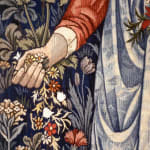SOLD TO THE DE YOUNG MUSEUM, SAN FRANCISCO: Flora and Pomona
Designed by Sir Edward Burne-Jones, William Morris and John Henry Dearle
176 x 102 cm
Further images
-
(View a larger image of thumbnail 1
)

-
(View a larger image of thumbnail 2
)

-
(View a larger image of thumbnail 3
)

-
(View a larger image of thumbnail 4
)

-
(View a larger image of thumbnail 5
)

-
(View a larger image of thumbnail 6
)

-
(View a larger image of thumbnail 7
)

-
(View a larger image of thumbnail 8
)

Provenance
Commissioned by James Fleming Esq, Aldwick Grange, Aldwick, West Sussex, 1920. James Fleming, a well known London restauranteur of the time was a keen collector of William Morris tapestries, he also had a weave of The Heart of the Rose, designed by Burne-Jones (sold Sotheby’s 1972, now at the Badisches Landes Museum in Karlsruhe), The Brook from 1916, and Ehret die Fraun, designed by Marion Prendersberger, now at the Whitworth Art Gallery, Manchester. Sold Sotheby’s 12th February 1965 - there acquired by Private Collection, Warwickshire.Woven at Merton Abbey in 1920.
Both inscribed and dated Merton Abbey 1920 in the border.
Tapestry woven wool and silk on a cotton warp.
Dimensions: 176 x 102cm; and 180 x 100cm.
Exhibited: Brussels, Musée Moderne, Exposition Retrospective de Peinture Anglaise (18e & 19e siècles), organisée à l’initiative de l’Union Anglo-Belge avec le concours du Gouvernement Belge, 12 octobre – 1er décembre 1929. (Avant-propos du Baron Moncheur), page 46, cat. nos. 118 & 119.
Both Flora and Pomona bear the original exhibition label sewn onto the lining on the reverse.
Related Literature:
Martin Harrison and Bill Waters, Burne-Jones, Barrie and Jenkins, London, 1973, p.138.
Linda Parry, William Morris Textiles, Weidenfeld and Nicolson, London, 1983, p. 108ff.
Peter Nahum and Hilary Morgan, Burne-Jones, The Pre-Rafaelites and their Century, London, 1989, Vol. I p. 81.
Linda Parry, William Morris, Victoria & Albert Museum Exhibition catalogue, 1996, no.M.126.
Charlotte & Peter Fiell, William Morris (1834-1896), Taschen, Italy, 1999, p.147.
For an illustration of Sir Edward Coley Burne-Jones’ Flora, gouache and gold paint on paper, 152 by 58cm, see Peter Nahum, Burne Jones, The Pre-Rafaelites and their Century, Hurstpierpoint, 1989.
Flora and Pomona were the first two Morris & Co. tapestries for which Burne-Jones designed the figures in 1884. Having moved to Merton Abbey in 1881 in order to enable tapestry production on a much larger scale than before Morris’ first panel was The Goose Girl, taken from a book illustration by Walter Crane. Morris was not entirely satisfied with the result, however, as can be gleaned from his remarks in a letter written to his wife Jenny on 14th April 1883, ‘I thought the Goose Girl was not bad, my dear, on the whole: but when all is said it was not a design quite fit for tapestry, except for the landscape background, which looked very well indeed’. Linda Parry (in William Morris Textiles) notes that Morris was quick to acknowledge that Burne-Jones, as chief tapestry designer, was one of the company’s greatest assets, and his designs of figures ‘established Morris& Co. tapestries as the most artistic pieces woven in the nineteenth century’. Morris’ pleasure at Burne-Jones’ designs for Flora and Pomona is evident in another letter to Jenny dated 28th February 1883, ‘Uncle Ned has done me two lovely figures for tapestry, but I have got to design a background for them. I shall probably bring them down [to Kelmscott Manor] next time I come for my holiday task.' Burne-Jones, being a close friend and associate, was paid a reduced rate of £25 for each design (Crane had been paid £150 for The Goose Girl).
An excerpt from William Morris’ Arts and Crafts lecture, Textiles, 1888:‘The noblest of the weaving arts is tapestry: in which there is nothing mechanical: it may be looked upon as a mosaic of pieces of colour made up of dyed threads, and is capable of producing wall ornament of any degree of elaboration within the proper limits of duly considered decorative work. As in all wall-decoration, the first thing to be considered in the designing of tapestry is the force, purity and elegance of the silhouette of the object represented, and nothing vague or indeterminate is admissible. But special excellencies can be expected from it. Depth of tone, richness of colour, and exquisite gradation of tints are easily to be obtained in tapestry; and it also demands that crispness and abundance of beautiful detail which was the especial characteristic of fully developed Medieval Art’ Morris also stated that the technique of tapestry was ‘so deep, rich and varied, as to be unattainable by anything else other than the hand of a good painter in a finished picture’.
Condition: They are in an excellent state of conservation with fresh colours and undamaged surface as I hope you can see from the photographs of the details. The presence of the undisturbed sewn-on labels from the 1929 exhibition would suggest that the linings are the original ones. Certainly since 1960 they have been hung, without ever being moved, away from direct sunlight. We have not cleaned them.
We are grateful to Linda Parry of the Victoria & Albert Museum (Curator of the 1994 exhibition William Morris), Dora Murphy of the National Museum of Ireland, and Frances Pritchard of the Whitworth Art Gallery, Manchester, for their assistance with the cataloguing of these works.








